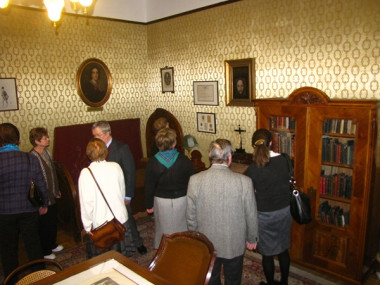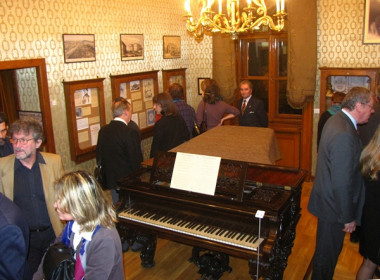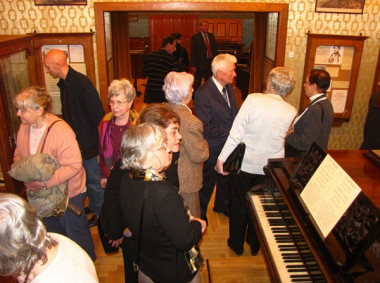Liszt and Budapest
The syllabus of the exhibition covers Liszt’s stay in Pest-Budapest from his first appearance in 1823 till his farewell concert in 1886. The main themes of the exhibition are the events of Liszt’s stay in Budapest.
Furthermore we would like to present Pest-Budapest’s cultural development in Liszt’s era and the composer’s significant role in the foundation and improvement of the institutions of the Hungarian reform-age especially in view of the concept of making the Academy of Music internationally recognized. Therefore our exhibition,

which is based on the connection between Liszt and Pest-Buda or later Budapest, apart form the presentation of the events, is to demonstrate the diversity of Liszt’s Hungarian identity. When Liszt gave his first concert in 1823, his father phrased the text of the poster on behalf of him saying that Liszt devotes his talent to serve the glory of his country.
This moment is emblematic because the efforts of István Széchenyi and Miklós Wesselényi to create the civic society is about to come true. Széchenyi founded the Hungarian Academy of Science in 1825. In the syllabus of the exhibition the paralellism between Széchenyi and Liszt is obvious because they have already met personally in 1839. and we learn from Széchenyi’s diary that he and Lajos Batthyany entertained Liszt as their guest at their homes. The base of the mutual sympathy was probably the similarity of their way of thinking. Liszt also supported the Hungarian culture in all possible ways. It is well known that his charity concerts helped to establish and develop several cultural institutions and contemporary associations such as the Hungarian National Theatre or the National Conservatory. The Hungarian Academy of Music couldn’t have become an insitution of high standing without Liszt’s worldwide concept. What is less known that based on the letter of Ferenc Doppler, the establishement of the Hungarian Philharmonical Society was also initiated by Liszt.

The project was warmly welcomed by Ferenc Erkel and the Doppler brothers who founded the Society eventually. The minor but important assistances of Liszt in Hungary are less known, for example that he supported the male choruses, the so called DALÁRDA not only with his compositions but with his judgements and suggestions. Thus, in the middle room of the museum not only the events of his stay in Pest are displayed but the ones when he supported the capital’s musical life from abroad. When he was at home he attended regularly to the rehersals of various choirs, teached them, added less known compositions to their repertoire but he even liked to go the students of the nonnes to teach them, to accompany them or to play to them.
Liszt always emphasized that he was to support the Hungarian culture as a performer and especially as a composer. His music was present at almost every important Hungarian event.
The exhibition features the compositions which were created in Budapest: the Coronation Mass, the Ode for St. Cecile the melodrama Des toten Dichters Liebe (on verse of Jókai), the Via Crucis, or the Symphonic Poem „The Battle of Huns” which was finished and performed for the first time here.We will also mention his concerts in Pest with the critics’ opinion. The benefit concerts or the concerts held at his friends’ (for example Munkácsy, Jókai) saloons are displayed separately, thus, the visitors will have a taste of the diverse bond between the Hungarian poets, writers and artists.
Another part of the exhibition is about Liszt’s ecclesiastical acquaintances and the events of this topic (his admission to the franciscan order, his concerts at the nonnes, the inauguration of the Hermina chaple).
The connection between Liszt and Budapest is displayed not only by our temporaly but also by our permanent exhibition. These relics are presented at their original places.

The exhibition on the ground floor is thematical: it introduces a collection of Liszt’s relationships in Hungary. He was regular participant of the Association of Hungarian Writers and Poets founded by Mór Jókai. From contemporary reports we know that he understood the Hungarian texts and didn’t need an interpreter. Another part of the exhibition is about Liszt’s ecclesiastical acquaintances and the events of this topic (his admission to the franciscan order, his concerts at the nonnes, the inauguration of the Hermina chaple. Among the documents downstairs we would like to call attention to the beautiful guestbook of the nonnes with the signature of Liszt. The exhibition downstairs are made up of two containers with the help of the National Cultural Foundation, the Ministry of National Development and the Novastore. In the exhibiton on the first floor we displayed az interactive map where the visitors are able to search for place in Budapest in connection with Liszt. This part of the exhibition joins to the recent book written by our colleague Ágnes Watzatka with the assistance of Miklós Török titled „Following Franz Liszt’s footsteps in Budapest”. The book can be bought both in English and Hungarian language.



